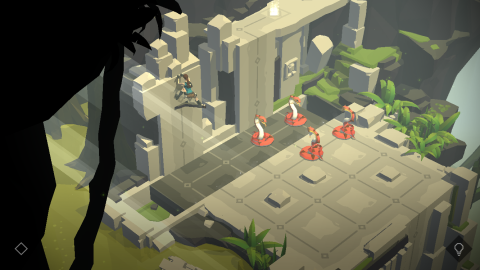At the Mobile Games Forum in London last week, we were shown a slide during a presentation which displayed the top grossing mobile games. Somewhat unsurprisingly, the majority were free to play (F2P) titles like Clash of Clans, or Candy Crush; games designed to entice the widest audience, but also designed to exist as an ad-engine, or IAP-encourager. These revenue for these titles in 2015 were in the hundreds of millions, and in the main hall, this talk seemed to be screaming to its audience of app developers – why would you not follow this model?
Later that day, in a much smaller side room, Patrick Naud, Head of Studio at Square Enix Montreal, in charge of widely-familiar intellectual properties like Tomb Raider, and Hitman, was give a much smaller platform to make the case for premium titles.
Charging $5 a pop might seem crazy to some studios – is that price point too high for a mobile title? What about those millions in ad revenue that we won’t get? Naud, however, outlined why the model works for Square Enix, and spent the next half hour making a good case for the continuing existence of premium mobile titles.
“Limiting the risk”
Naud and the Square Enix Montreal team began developing games for mobile in 2013 after they were given the “tablet challenge”. The studio owned numerous intellectual properties, and wise to the fact that porting old titles rarely produces a product a studio can be proud of, they decided to let its Montreal office develop original games based on these IPs.
Many studios have created products that use familiar titles to create a F2P product, so why did SEM choose to create a premium title? Naud explains that “Coming from console – it’s an easier adjustment,” that it’s “limiting the risk.”

Lara Croft Go – Square Enix Montreal turned the console-based 3D action platformer into a turn-based puzzler for mobile
It makes sense, when a studio comes from selling a million units at $60 in the first week of a new Tomb Raider console release. If you’ve got a core audience paying that much for a game featuring a beloved character, the idea of giving Lara Croft away for free seems nuts.
However, Naud acknowledges that the studio initially over-estimated the conversion rate of its console audience.
After conducting market research, the studio found that only one-third of their users were willing to pay for a mobile game. But this audience also needs to like the genre, or the approach – developing the Tomb Raider IP for mobile won’t produce the same game as a console title. Once compatible devices were taken into account, SEM found that only 3-10% of its existing audience would pick up this mobile game – depending on price point. And $4.99 for a mobile game is high.
Were they still convinced premium was the way to go?
Premium exposure
“It works,” says Naud, when discussing the combination of a premium game on a premium brand with a known IP. There’s also access to the existing, highly-populated social channels, “and with known games, you’ve also got access to the gaming press,” he adds.
“Journalists love premium games,” says Naud. “If you have a name attached – even better.”
However, this is far from the key driver of audience. As noted, only a certain percentage of existing users and games enthusiasts will go for the title. So where does the rest of the audience that makes a premium title worthwhile come from? The App Store.
When Hitman Go was chosen as the editor’s choice on the App Store, it received 7.5 million views. When Lara Croft Go was released, it generated 11 million views. It’s this initial hit that’s most important, interestingly, when Lara Croft Go was voted best game of 2015 by Apple, it only got 2 million views that week.
But how to get that kind of exposure? “Quality is needed to get that exposure,” says Naud. Though that surely doesn’t guarantee an Editor’s Choice when you release a game (though with Square Enix’s PR power, it would certainly makes it easier), Naud believes this is necessary for a premium game to get that kind of exposure. Even without a pre-existing IP. “Premium still works, you just need to be super creative.”
It’s not a technique that will work every time, no doubt, but there’s been some interesting case-in-points recently. Take Lumino City, for example. It’s developer State of Play is far smaller a studio than Square Enix, and certainly doesn’t have the pre-existing, historically console-boosted IP that SE has, but their hand-made approach, dedication to character, narrative and originality won them huge amounts of exposure.
Another key point from the earlier keynote demonstrating that F2P games were the biggest revenue generators was the age-old adage that you need to adapt or die – users get bored, and will eventually move on. Is it true to say that this is exactly what premium titles have been doing while F2P games have been doing the same old thing for the past few years?
If studios like Square Enix has anything to do with it, we may well be approaching an era of premium titles on mobile. As Naud concludes: “Everyone’s looking for something new.”
Patrick Naud can be found on Twitter @DrNaud, and you can find out what else Square Enix Montreal is up to on its website. Furthermore, read our review of Lara Croft Go.

